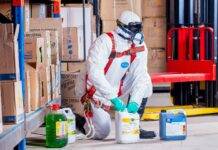
5 Main Substances Covered by COSHH
5 Main Substances Covered by COSHH : COSHH, or the Control of Substances Hazardous to Health, is a crucial set of regulations designed to safeguard individuals from exposure to hazardous substances in the workplace. These regulations encompass various materials that could pose health risks if not handled properly. Here, we delve into the five main substances covered by COSHH and their significance in workplace safety.
I. Introduction to COSHH
COSHH is a legal framework that requires employers to control substances that are hazardous to health. The regulations aim to protect workers and others from potential risks arising from exposure to harmful substances used in various industries.
II. Understanding COSHH Regulations
A. Importance of COSHH
COSHH regulations hold immense importance as they ensure that employers take necessary measures to prevent or control exposure to hazardous substances, thereby safeguarding the health of employees and others affected by workplace activities.
B. Scope of COSHH Regulations
The scope of COSHH is expansive, covering a wide array of substances. The five main categories include:
III. Main Substances Covered by COSHH
A. Chemicals
Chemicals encompass a broad spectrum of substances used across industries. From cleaning agents to manufacturing materials, proper handling, storage, and disposal of chemicals are critical to prevent harmful exposure.
B. Fumes
Fumes, emitted during welding, soldering, or various industrial processes, contain particles and gases that, if inhaled, could lead to respiratory issues and long-term health problems.
C. Dusts
Dust particles, prevalent in construction, woodworking, and other industries, pose risks of respiratory ailments when inhaled over prolonged periods.
D. Biological Agents
Biological agents include microorganisms like bacteria, viruses, or fungi present in healthcare, laboratories, and agricultural settings, necessitating stringent precautions to prevent infections and diseases.
E. Nanotechnology
With the advancements in nanotechnology, exposure to nanoparticles in manufacturing processes requires careful handling due to their potential health impacts.
IV. Hazards Posed by These Substances
Each category of substances covered by COSHH presents specific hazards, ranging from respiratory issues to skin irritations, infections, and long-term health complications.
V. Risk Assessment and Control Measures
Employers must conduct thorough risk assessments to identify potential hazards and implement control measures to mitigate risks, such as ventilation systems, personal protective equipment (PPE), and substitution with safer alternatives.
VI. Employer Responsibilities under COSHH
Employers bear the responsibility of ensuring proper risk assessments, implementing controls, providing necessary training, and maintaining records to comply with COSHH regulations.
VII. Importance of Training and Information
Training employees on handling hazardous substances and providing comprehensive information on risks and safety measures are integral aspects of COSHH compliance.
VIII. Compliance and Enforcement
Authorities enforce COSHH regulations through inspections and penalties for non-compliance, emphasizing the seriousness of maintaining a safe working environment.
IX. Conclusion
In conclusion, COSHH regulations play a pivotal role in safeguarding individuals from the adverse effects of hazardous substances in the workplace. Understanding and adhering to these regulations is vital for promoting a healthy and safe work environment.
Why COSHH is Essential for Workplace Safety
COSHH (Control of Substances Hazardous to Health)
FAQs
1. Are all substances hazardous under COSHH?
Not all substances are covered, only those deemed hazardous to health are included.
2. How often should risk assessments be conducted under COSHH?
Risk assessments should be regularly reviewed and updated, especially when there are changes in processes or substances used.
3. Is training mandatory for all employees under COSHH?
Yes, adequate training on handling hazardous substances is essential for all employees exposed to such materials.
4. Can substitution be an effective control measure under COSHH?
Yes, substituting hazardous substances with safer alternatives is a recommended control measure under COSHH.
5. What penalties can non-compliance with COSHH regulations lead to?
Non-compliance may result in fines, legal actions, or even closure of the workplace, emphasizing the importance of adherence to these regulations.
























